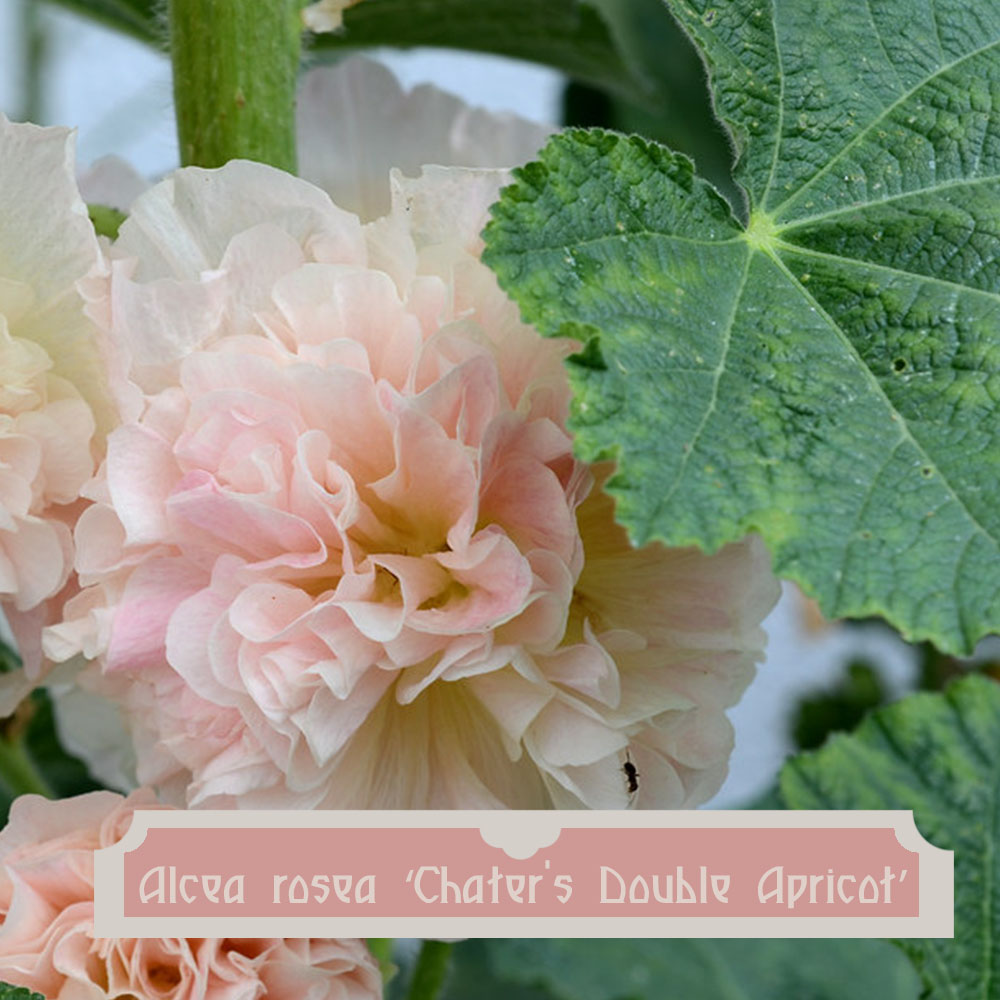No products in the cart.
Alcea rosea ‘Chater’s Double Apricot’
Giant 2m tall apricot colored flowers
Rated 0 out of 5
0 customer reviews
4,90 €
Only 19 item(s) left in stock!
Tags: couleur, feuillage persistant, fleurs, graphique, jardin de rocaille, perennial, potted plant, secheresse, vivace, vivace en pot
SKU: pda481
Category: Bees and Butterflies, Bouquet, Evergreen, Frost Hardy, Make it Pop, Rewild, Self-Seeding Annual

Alcea rosea ‘Chater's Double Apricot’
4,90 €
Only 19 item(s) left in stock!
Alcea rosea ‘Chater’s Double Apricot’ is a spectacular biannual that brings elegance to the garden with its stunning, double apricot-colored blooms
The flowers appear as lush pompoms, carried high on sturdy stems that can grow up to 2 meters tall.
The leaves are tough, covered in fine hairs, allowing for high drought tolerance and heat resistance.
Blooming throughout the summer, this variety attracts butterflies and bees, while showing impressive resilience in tough conditions.
Though each plant completes its life cycle in only two/three years, it reseeds in an abundant manner – providing continous flowering through the ages.
It thrives in sunny spots with well-drained soil but can also tolerate light shade.
👨🌾GARDENING TIPS👨🌾:
-
-
- 🌱They prefer light, dry, and poor soils with a chalky tendency—gravelly or rocky debris soils – they grow in pavement in most French cities so the need for care here is very limited
- ☀️ Alcea loves loves the sun
- ✂️ Cut back dead foliage after flowering, or pull out and discard – growing as annuals or biennials can help limit the spread of rust
- Because of their vertical structure, it’s interesting to pair them with movement – Miscanthus, Nepeta, Stipa– and bushes – Salvia, Lotus hirsutus, Santolina.
-
Learn move about growing Hollyhocks:
The Tales & The Botany:
🌸 Floral Morphology
Alcea rosea, commonly known as Hollyhock, produces large funnel-shaped flowers arranged in vertical racemes along sturdy stems reaching 1.5–3 meters in height.
The flowers are actinomorphic and hermaphroditic, with five fused sepals forming the calyx and five fused petals forming a wide corolla 5–10 cm across.
Numerous stamens are fused into a column surrounding the pistil, and the ovary is superior and bicarpellate. Leaves are alternate, palmately lobed, and coarsely toothed, with rough hairs on both surfaces.
Flowering occurs from late spring through summer, attracting bees, butterflies, and other insect pollinators with abundant nectar and vibrant colors ranging from white to deep red.
🧬 Reproductive Biology
Pollination is primarily entomophilous, promoting cross-fertilization. Fruits are schizocarps composed of several mericarps, each containing multiple seeds. Hollyhocks can propagate by seeds, which germinate optimally after exposure to cold, making them well-adapted to temperate climates.
🦋 Ecology & Cultivation
Hollyhocks thrive in well-drained, fertile soils under full sun and tolerate moderate drought. They are commonly cultivated along walls or borders for their tall, vertical floral display and long-lasting blooms.
Historically, leaves and flowers have also been used for their mucilaginous properties. Light pruning after flowering encourages future growth and helps maintain healthy stems.
Other names
Hollyhock
Rose tremière
Passe-rose
Origin:
Europe/Asia
| Weight | 0,5 kg |
|---|---|
| Flower Color | 🟠 Orange |
| Flowering | June, July |
| Exposure | Full Sun |
| Frost Tolerance | -10°C to -15°C |
| Soil | Well-Draining |
| Size | 1.80m H x 0.3m W |
Reviews
0
Rated 0 out of 5
0 customer reviews
5
0
4
0
3
0
2
0
1
0
Only logged in customers who have purchased this product may leave a review.
You may also like…
Santolina chamaecyparissus
A fragrant, evergreyshrub with little yellow button flowers in summer
A fragrant, evergreyshrub with little yellow button flowers in summer
Rated 0 out of 5
Lotus hirsutus
A semi-evergreen shrub with soft, silver-grey leaves that loves the sun
A semi-evergreen shrub with soft, silver-grey leaves that loves the sun
Rated 0 out of 5
Stipa tenuifolia
A species of long, blonde, feathery grass.
A species of long, blonde, feathery grass.
Rated 0 out of 5
Miscanthus sinensis Purpurascens – 9×9 cm
Container Size: 9×9 cm
Container Size: 9×9 cm
Rated 0 out of 5
Related Products
Euphorbia myrsinites
Known for its draping form of silver-gray foliage and radiant blooms.
Known for its draping form of silver-gray foliage and radiant blooms.
Rated 0 out of 5
Sedum album
A low, multi-color ground cover.
A low, multi-color ground cover.
Rated 0 out of 5
Billbergia nutans
A bromeliad featuring a three colored, striped flower
A bromeliad featuring a three colored, striped flower
Rated 0 out of 5
Tradescantia Blushing Bride
Gorgeous blushes of pink and white that appear in the coldest nights.
Gorgeous blushes of pink and white that appear in the coldest nights.
Rated 0 out of 5
Glechoma hederacea
A sweet smelling ground cover, producing little blue flowers all summer long.
A sweet smelling ground cover, producing little blue flowers all summer long.
Rated 0 out of 5
Solidago ‘Golden Shower’
Beautiful showers of yellow flowers
Beautiful showers of yellow flowers
Rated 0 out of 5
Jacobaea maritima
A wooly white perennial plant from the Mediterranean region.
A wooly white perennial plant from the Mediterranean region.
Rated 0 out of 5
Tanacetum densum subsp amani
A shrublet composed of soft, finely divided silvery gray-white leaves.
A shrublet composed of soft, finely divided silvery gray-white leaves.
Rated 0 out of 5
Erigeron kavinskianus
A daisy-like carpet of flowers
A daisy-like carpet of flowers
Rated 0 out of 5
Cerastium tomentosum var. columnae
A grey-green spreading ground cover from the mountains.
A grey-green spreading ground cover from the mountains.
Rated 0 out of 5
Mentha x piperita ‘Chartreuse’
A spicy mint, known for its use in the production of liqueurs and herbal teas.
A spicy mint, known for its use in the production of liqueurs and herbal teas.
Rated 0 out of 5
Echinops ritro
Tall, electric blue globe thistles
Tall, electric blue globe thistles
Rated 0 out of 5
Vinca minor
Looping elegance and ability to form a low flowering ground cover
Looping elegance and ability to form a low flowering ground cover
Rated 0 out of 5
Artemisia alba subsp camphorata
A highly fragrant, grey-green bush.
A highly fragrant, grey-green bush.
Rated 0 out of 5
Artemisia vulgaris Oriental Limelight
Striking green and yellow variegated foliage.
Striking green and yellow variegated foliage.
Rated 0 out of 5
Satureja montana
A sweet smelling culinary herb from Europe
A sweet smelling culinary herb from Europe
Rated 0 out of 5
Achillea ptarmica Boule de Neige
White pompom flowers to attract bees to your garden all summer long.
White pompom flowers to attract bees to your garden all summer long.
Rated 0 out of 5
Hieracium maculatum Leopard
A native perennial with blue-green leaves and a tall yellow flower
A native perennial with blue-green leaves and a tall yellow flower
Rated 0 out of 5
recent view product
Ajuga reptans Atropurpurea
A low-growing dark purple groundcover with colorful blooms.
A low-growing dark purple groundcover with colorful blooms.
Rated 0 out of 5
Tinantia pringlei ‘Variegata’
A variegated Commelinaceae with cream-white stripes and dark sprinkles on top.
A variegated Commelinaceae with cream-white stripes and dark sprinkles on top.
Rated 0 out of 5
Aloe vera
A succulent known for the unctuous gel hidden in its leaves
A succulent known for the unctuous gel hidden in its leaves
Rated 0 out of 5
Echinacea purpurea
A perennial with purple flowers all summer long
A perennial with purple flowers all summer long
Rated 0 out of 5
Rosmarinus officinalis Majorca Pink
Mediterranean aromatic perennial with soft pink flowers
Mediterranean aromatic perennial with soft pink flowers
Rated 0 out of 5























































There are no reviews yet.